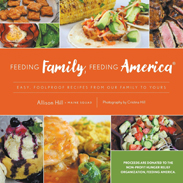
 |
The idea for this beautiful and elegantly simple cookbook arose from a desire to do good in a difficult time. When the COVID-19 pandemic began in the United States, Alison Hill and her family left their home in Atlanta, Georgia, to quarantine and self-isolate in their summer vacation spot in Ogunquit, Maine. After the Hill family logged into work and school from home each day, they would prepare and eat dinner together. Recognizing how privileged they were to have food security in a time that strained so many families financially, the Hills decided to write this cookbook to raise money for Feeding America. Feeding America is “the largest domestic hunger-relief program” in the United States, providing food relief for millions of Americans each year. Each cookbook purchase donates up to one hundred meals through this program.
While the mission behind the cookbook is weighty, the writing throughout the book is light-hearted and fun. Many recipe descriptions include anecdotes about family members or friends who inspired or simply enjoy that particular dish. One cocktail recipe calls for “1-2 jiggers vodka—or 3 if your kids are being really loud.” The descriptions also include helpful information such as cooking tips, recommendations for serving, and even quick recipes for what side dishes to serve with the main recipe. Between the chatty captions and the photographs of family members making and eating many of the recipes, this cookbook invites readers to feel like part of the family.
The recipes themselves are divided into sections for each meal of the day, as well as sections for appetizers, desserts, and cocktails. The Hill family’s goal with this cookbook is to provide easy, quick, and delicious recipes that a whole family or crowd can enjoy. Most recipes use basic pantry ingredients that are affordable and easy to find at any supermarket. The exceptions are a few recipes that call for lobster (after all, the Hill family developed their recipes on the coast of Maine) and filet mignon. The author seems to recognize how difficult or expensive these ingredients may be to acquire, as she also includes several recipes for using up the leftovers, so no part of the meal goes to waste. Other recipes are as basic as baked peanut butter toast or fluffy “Just What the Doctor Ordered” pancakes with a surprising ingredient.
Each recipe in the book is accompanied by a beautiful photograph of the dish and a simple icon in each corner that can help readers find a specific recipe quickly. There are almost no vegan or even vegetarian recipes, but many recipes are gluten-free by default. And because of their simplicity, nearly all recipes are easily modified for eaters with allergies or intolerances. All the recipes are one page long, except for an epic lasagna that seems worth the extra page-turning. While this is not meant to be a cookbook for beginners, most recipes are very simple, and the directions are clear enough for even the least experienced cooks to follow. Designed with busy families in mind, many recipes take minimal time and effort to prepare, and marinating time is often the longest step in a recipe. The dessert section is reminiscent of Sandra Lee’s Semi-Homemade Cooking, combining packaged foods with other ingredients to create tasty but easy delicacies like a one-bowl Kahlua cake. With a solid base of appetizing recipes to accompany its charitable mission, this cookbook allows its authors, as well as those who cook from it, to eat well while doing good.